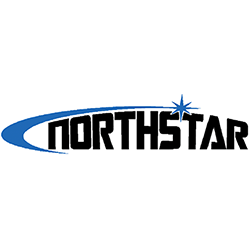Observer Name
Skiers 1-6 and UAC Staff
Observation Date
Friday, January 12, 2024
Avalanche Date
Friday, January 12, 2024
Region
Salt Lake » Mill Creek Canyon » Porter Fork » Main Porter
Location Name or Route
Main Porter
Elevation
8,600'
Aspect
Northeast
Slope Angle
Unknown
Trigger
Skier
Trigger: additional info
Unintentionally Triggered
Avalanche Type
Soft Slab
Avalanche Problem
Persistent Weak Layer
Weak Layer
Facets
Depth
2'
Width
Unknown
Vertical
250'
Caught
1
Carried
1
Buried - Fully
1
Accident and Rescue Summary
Full burial and companion rescue.
Comments
[Note from UAC Staff: We spoke to the reporting party and admire their frank assessment of the accident which could have easily involved multiple burials. The UAC danger rating for the day was High at the mid and upper elevations (above 8,000') and Considerable below 8,000' with the primary avalanche problem a persistent weak layer of faceted snow that formed following 6" of snowfall from Saturday, December 23, 2023 and was exposed to cold, clear skies until it was buried by snowfall on Thursday, January 4, 2024. A long-duration stormy period began on Friday, January 5, depositing several feet of snow and with strong winds. The reporting party traveled up Porter Fork and completed two laps in West Porter Fork. On their third ascent, they decided to exit Main Porter Fork from West Porter Fork. The avalanche accident occurred on their exit in Main Porter Fork where a skier in the party was caught, carried, and buried. Fortunately, a successful companion rescue recovered the buried skier and they were able to exit the accident scene without additional assistance.]
We did many things right today, but the day will be defined by a few mistakes. That’s appropriate, given the potential consequences, but we’d like to highlight both good and bad lessons here, as both are instructive and may help others.
First, we talked in detail about possible route options for today and nixed 99.9% of them due to UAC observations and forecasts, as well as our personal experience on the mountain this week. If we’re being honest, it was a bit tedious at times to reject a line (“too close to possible hangfire,” “requires a too-steep approach to get to the safe terrain we’d like to ski,” etc.). The back-and-forth went all night and continued through this morning as we started to climb. We ultimately settled on West Porter because, while not perfectly safe, it has route options that work well in higher-danger conditions. We did not, however, discuss how we’d exit, which is the first problem (more on that below).
We reset the skinner up West Porter and then skied two low-angle laps without consequence. On our third ascent, we discussed where we’d ski next, taking the same care to discuss lines we might ski. We discussed the safety of the new location, but didn’t discuss the safety of getting to that new location as the ski down to that location was a line we’ve skied a lot and is usually safe. (Skier 1 also had worried that the most direct route to Main Porter would carry us into a terrain trap/gully. He didn’t verbalize the concern (mistake as we could have discussed it), and started to ski off the West Porter saddle, bending left toward the “usually safe” line.
As we’ve been finding, “usually safe” hasn’t been a great indicator of current conditions.
We made it to the best part of the line. It’s an opening that leads into a wide and what usually feels like a mellow gully. It’s probably not even considered a gully as it’s quite wide. But it does have small hills on both sides that define the line, and break 35º in slope gradient.
- Skier 1 went first, stopping part way down the line to take some pics (mistake, but more on this later). This part of the line is under 30º.
- Skier 2 skied past Skier 1 and stopped 50 meters past Skier 1 to snap a few more pics (mistake, but more on this later). He stopped on the skier's right side of the gully near a tree.
- Skier 3 skied passed both and continued down another 100 meters in the middle of the line.
- Skier 4 skied closely behind Skier 3 but stopped in the middle of the line, near Skier 2 but to skier’s left of him, to look back up at Skier 1. Skier 4 was facing away from Skier 2, so his back was to Skier 2 as he looked uphill. Looking up, he saw a sluff coming off the side hill (on the side near Skier 2). It looked of decent size but felt more like a big sluff than a real avalanche.
- Skier 1 was above where the slide broke and yelled, “GET LEFT! SLIDE!” several times, then called the same into the radio (each of the skiers was carrying a radio).
- Skier 4 could see it coming and could hear Skier 1, but was enough to the side of the avy path that the slide missed him. In the time it took Skier 4 to turn his head from up slope to down slope he saw that Skier 2 was gone, and began to scream that Skier 2 was missing.
- The length of the slide path was shocking. It started from about 30 meters above Skier 2, to the skier’s right side of what everyone skied, and ran another 60 meters past Skier 2, all the way down past Skier 3 (who was out of the avy path, as he’d moved left when he heard the yelling, looked up-slope and saw the avalanche coming. Skier 3 grabbed hold of trees and was able to stay on his skis as the avalanche passed. The bulk of the avalanche passed to Skier 3’s right.
- We then confirmed Skier 2 was caught and buried in the avalanche.
- Skier 4 yelled, “everyone switch to search mode!” Skier 4 then got on the radio and said, “Skier 2, we are coming for you!” (Skier 2 confirmed later that he could hear this call over the radio.)
- Skier 4 immediately got a reading on his beacon for about 20 meters downhill. Skier 1 skied down to Skier 4, but was having problems getting his beacon into search mode. (Note: if you have the Pieps Micro with the search button, get it replaced immediately. It requires a two-button push sequence and neither worked. This wasn’t user error: the buttons get frozen, even kept warm inside a jacket. It’s a death warrant.) Skier 1 ultimately just turned it off, because it was interfering with Skier 4’s beacon search. This cost us precious seconds to minutes.
- Skier 3 was still 30 meters below. He started a scan but was out of range to get a reading on Skier 2’s location. Skier 3 transitioned and started uphill until the beacon gave a reading confirming the proximity of Skier 2.
- After maybe 4-5 minutes skiers 1 and 4 felt like we were on top of the buried Skier 2. Skier 1 had his probe out and started jamming it into the snow, whenever Skier 4 seemed to be settling on a location (given that skier 1 couldn’t use his beacon due to it malfunctioning). The lowest reading we were getting on the beacon was around 1.7 meters.
- Skier 1 felt like he got a probe strike, but wanted another probe out to confirm while he got his shovel ready.
- Skier 4 got his probe out but wasn’t able to get another confirmed strike.
- At this time, a party of two skiers (Skiers 5 and 6) that we had met on the West Porter saddle skied down to us. They had seen the probes and knew there was a problem. We asked them to get their shovel out and help, which they immediately did. (We are so grateful they came upon us. Their write-up is below.)
- We decided to start doing a beacon search again to see if we could get a closer reading, as the original site hadn’t yet been successful. A problem briefly arose as the new skiers had not yet switched off their beacons, so Skier 4 got a few bad readings initially. (Lesson: make sure EVERYONE has their beacons in search, not send, mode.)
- Fortunately Skier 3 had his beacon back out and was able to follow the signal slightly up slope a few more feet. From there Skier 3 immediately got a solid probe strike, Skier 1 confirmed with a second, and the digging began in earnest. We started to dig downhill from the perceived location of Skier 2. See this for why downhill.)
- At this point we were probably 7-8 minutes since initial burial.
- Skier 3 and Skier 1 started with shovels pushing snow downhill. Not finding Skier 2, Skier 3 checked his beacon again and saw we were still one yard too low. Skier 1 and 3 moved uphill and shoved together to move the snow out of the way.
- Skiers 3 and 1 took on the main digging, while the two skiers who came upon us took on the role of shoveling the snow away from the main diggers.
- Fairly quickly skier 3 had a successful shovel strike and visually confirmed we had found Skier 2. The strike on buried Skier 2 was on his lower leg and we realized that his legs were downhill and his head was uphill. Skier 3 used a combination of shovel and hands to remove snow as quickly as possible while Skier 1 continued pushing snow out of the way with his shovel.
- We were able to locate buried Skier 2’s head and face. He had passed out, his lips were turning a light blue color, and it was difficult to tell if he was breathing. Skier 3 came in closer and could hear very light breathing. The breathing became a little deeper but Skier 2 still did not regain consciousness.
- Skier 2 was later measured to have been buried about 4 feet deep.
- Once Skier 2’s head was out everyone was asking if he was breathing. Nobody was quite sure at first. Skier 2’s lips were blue and initial breathing was not detected. We started to ask who would be best to start CPR. But about that moment, as Skier 2 was being pulled completely out of the hole by Skier 3, Skier 2 started to take shallow breaths.
- As we moved Skier 2 a bit, his breathing became deeper, and slowly started to regain consciousness. We didn’t need to start CPR and he started moving around. A couple of minutes later, he was able to sit up and answer questions accurately about his name, the day, etc.
- We believed he was badly injured. His arm looked contorted in a way that made it look broken or dislocated. We also weren’t sure how well and fast he’d come back. So Skier 4 called 911 to start the process of getting SAR up to potentially help with an extraction. The call went through to Park City and was then transferred to Salt Lake. We gave the dispatcher the GPS coordinates to where we were, using a Google Maps pin to identify the coordinates. Skier 4 stayed on the line with 911 as Skier 2 slowly regained consciousness. Skier 2 was panicked as he came to, but within a minute or two became aware he was out and safe. He was able to stand within another minute or two and confirmed he did not have any injuries. Skier 4 told 911 that it seemed we would not need emergency help and was able to hang up, canceling the request.
- Skier 2 put his skis back on. One pole was sticking straight out of the snow 100 ft down the hill (good thing we didn’t just rush to where that pole was!). He lost his other pole. But that’s it.
- Skier 2 said afterward that as the snow hit him, he thought he could angle skier’s right out of it, but then it quickly turned him over, forcing his head down slope. He said he didn’t feel like it pushed him far (we estimate about 7 meters) and that he tried punching his arms out of the snow as he slowed, but quickly found his arms were totally stuck. He could hear the snow rushing over where he was buried for a bit and that it slowly got darker as it ran by.
- He assessed he hadn’t moved far and wasn’t too deep and had confidence we would find him quickly. He could hear us on the radio. So he tried to calm his breathing and wait. He said the breathing wasn’t hard or labored.
- He said he started to dream and then the dream turned into Skier 3 saying an audible prayer, which is when he started to come out of unconsciousness. (Good thing he didn’t hear Skier 1 swearing.)
- The party of two skiers made sure we had jackets and were put back together. They skied out and we promised to meet up in the parking lot to exchange phone numbers and debrief.
- Skier 1 gave Skier 2 his poles, and Skier 1 skied out with the single pole we found in the debris.
Things that went well:
- First, we planned the day well. We were meticulous about removing from consideration anything we thought likely to slide. That narrowed down our options considerably. It was supposed to be a special ski day for us, and felt a bit less special because of the constricted terrain choices. But we were smart about where we *chose* to ski. We were less smart about how to exit. More on that below.
- Skiers 1, 3, and 4 communicated well throughout. We yelled beacon readings as the beacons narrowed in. We communicated about the coming avalanche (which really helped Skier 3 so we didn’t have multiple burials), switched to search mode, alerting the buried person we were coming on the radio, and took different roles (main beacon searcher, probers, and shovelers).
- Skier 3 mentioned being grateful his beacon was on a leash so it was easy to switch from probing to searching as we tried to dial in the reading. This is something Skier 4 will start doing as he was in his pocket so it had to be set down as tasks and priorities changed. (Note that the two others mentioned that their beacons were harder to reach under layers of clothing. Something to consider.)
- Skier 1 was very quick on the draw with the probe and initial shoveling.
- Skiers 1 and 3 were beasts at shoveling.
- We were grateful for two additional skiers and their extra shovels to move snow away from the main dig.
Mistakes:
- We should have discussed the line we were taking more to get to our next area. It’s a line we know and have skied many times, but didn’t account for or understand the risk of the steeper slope adjacent to us.
- The pieps beacon that malfunctioned did cause some delays and confusion at the start, costing us a few minutes. Skier 4 wanted a second beacon to confirm the readings he was getting, but ultimately we should have turned Skier 1’s beacon off sooner once we realized it was having problems.
- Even though the main part of the line is less than 30 degrees, we should have skied more spaced out, given the high danger day. Had skiers 3 or 4 also been buried this would have been a very different write up.
- Pictures. The few times we put ourselves in danger today mostly resulted from pictures. The pictures had us stop in unwise places, and take focus off the mountain (watching, listening). No Strava or Instagram write-up is worth having a full burial UAC write-up. If we’re skiing for the social media dopamine hit, we’re skiing for the wrong reasons. Especially on a high danger day like today, the phones should have stayed in our pockets so we could be more aware of conditions.
- We should practice beacon burial retrievals more often. That was extremely stressful.
We feel lucky and grateful today.
Skiers 5 and 6:
A party of two, Skier 5 and Skier 6, had followed the party of four’s ski tracks down Main Porter from the WP saddle. Skier 5 was leading down the hill when he noticed the party of four had stopped, Skier 5 thought they had stopped for a moment to deal with an equipment issue since the debris field was not visible from where he was standing. However, as Skiers 5 and 6 were about to go on their way, Skier 5 noticed an avalanche probe was being used and quickly notified Skier 6 of the avalanche.
They did a quick assessment of the area for another potential avalanche and made sure to stay mostly skier’s right of the steeper hillside on the left.
From there, the rescue party put Skiers 5 and 6 to work to remove snow from the area once the victim was found.
Skiers 5 and 6 stayed with the party once we knew the victim was able to ski out and had enough warm clothing to make it back to the trailhead.
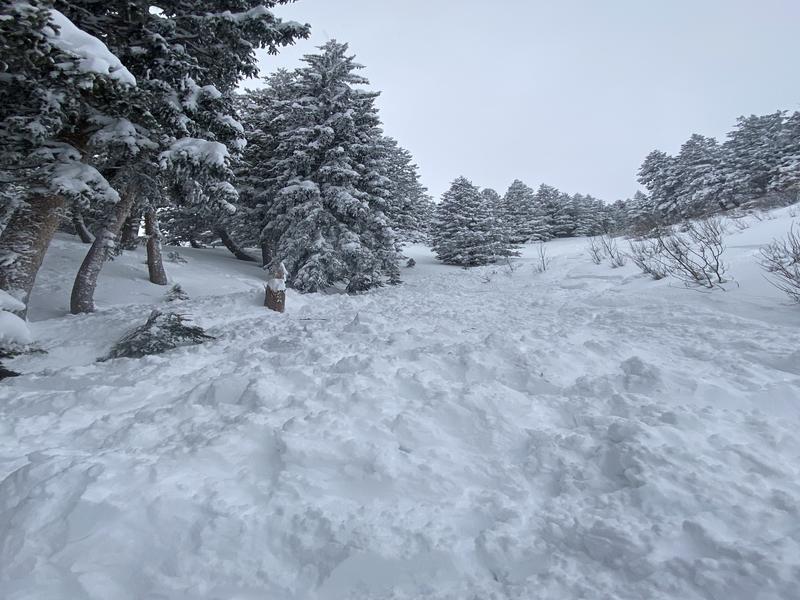
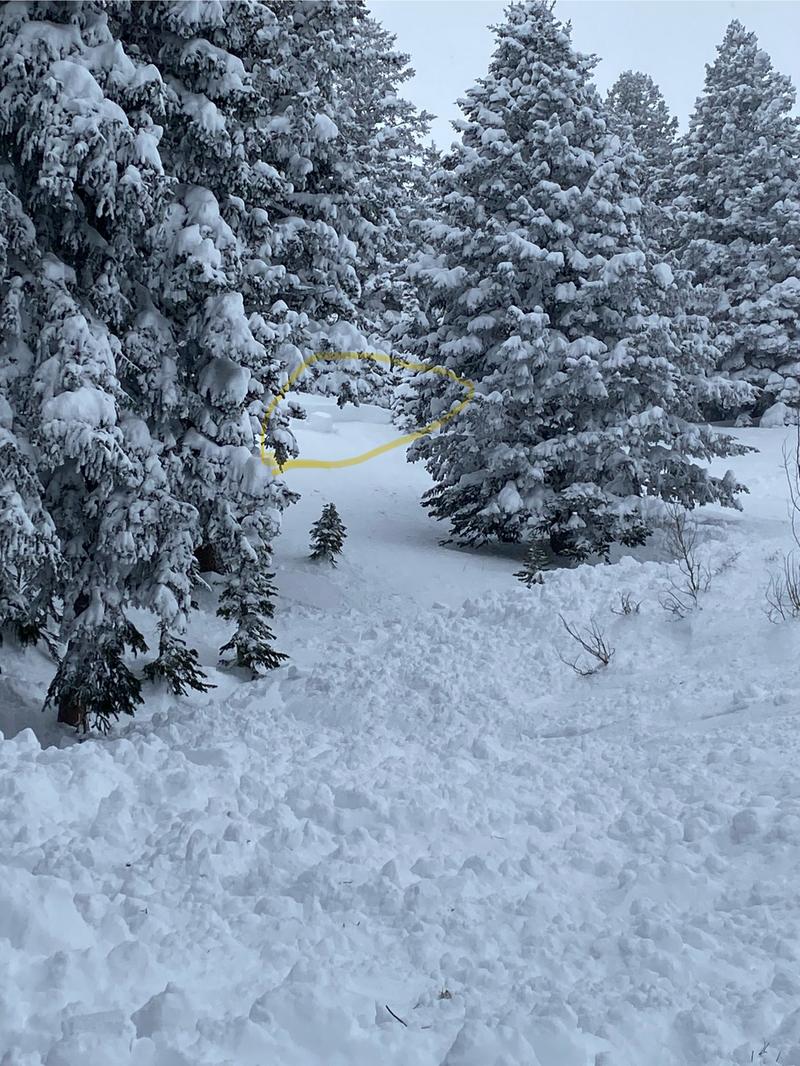
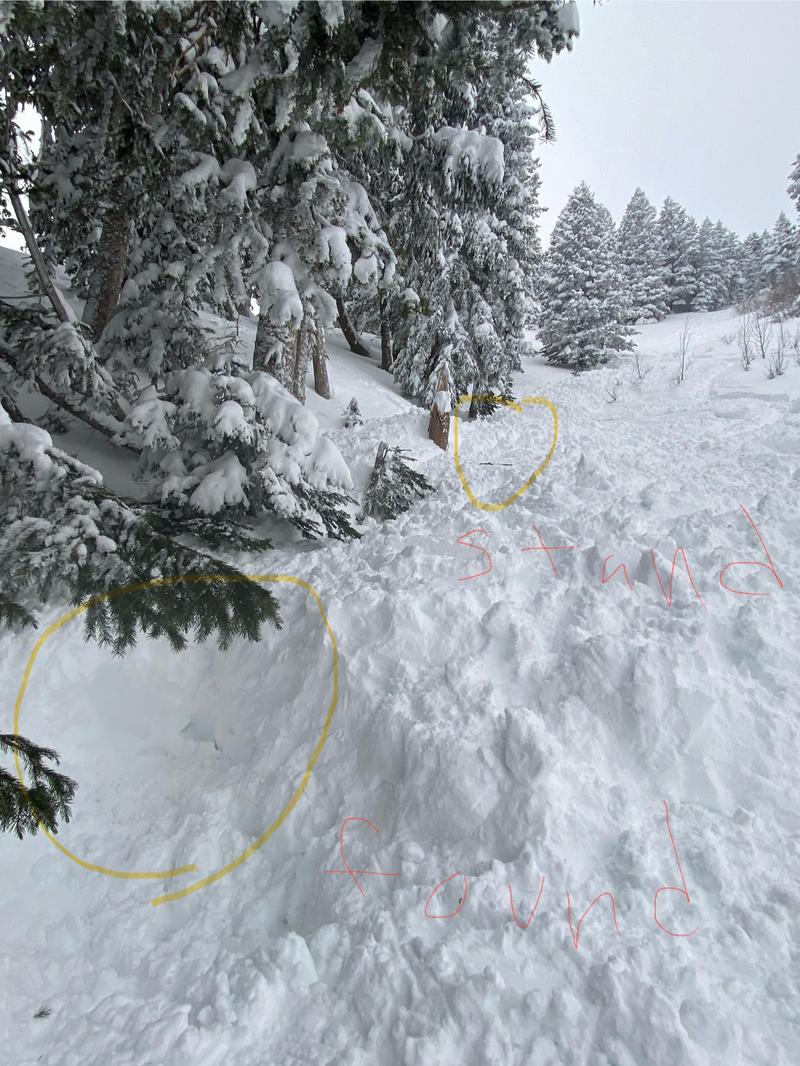
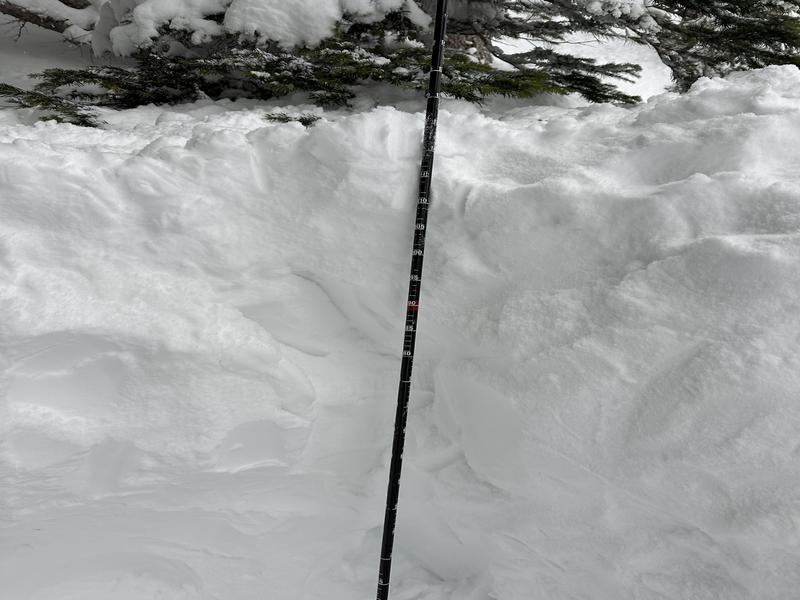

Coordinates



